Description of the Hydrologic Bike 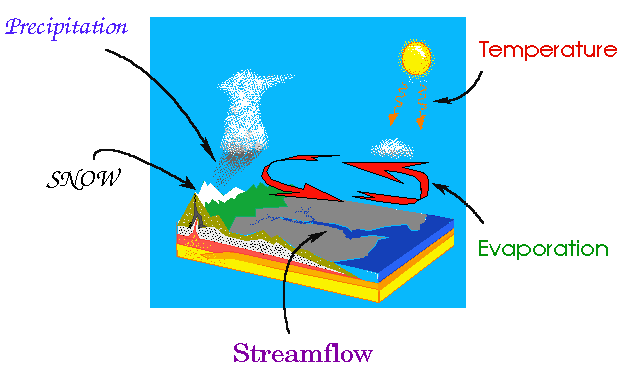 This is an educational activity module about the movement of water on the planet Earth. The module includes a discussion of h2o movement in the United States, and it likewise provides specific information about h2o motion in Oregon. The scientific discipline in the field of physical geography that deals with the water cycle is called hydrology. It is concerned with the origin, distribution, and properties of water on the globe. Consequently, the water cycle is besides called the hydrologic cycle in many scientific textbooks and educational materials. Nearly people accept heard of the scientific discipline of meteorology and many too know about the science of oceanography because of the exposure that each subject field has had on television. People watch Boob tube weather personalities virtually every day. Celebrities such as Jacques Cousteau have helped to make oceanography a usually recognized science. In a broad context, the sciences of meteorology and oceanography draw parts of a serial of global concrete processes involving h2o that are as well major components of the scientific discipline of hydrology. Geologists describe another part of the physical processes past addressing groundwater movement within the planet's subterranean features. Hydrologists are interested in obtaining measurable information and noesis about the water bike. Also of import is the measurement of the amount of h2o involved in the transitional stages that occur as the h2o moves from one procedure within the bicycle to other processes. Hydrology, therefore, is a broad science that utilizes information from a broad range of other sciences and integrates them to quantify the movement of water. The fundamental tools of hydrology are based in supporting scientific techniques that originated in mathematics, physics, engineering, chemistry, geology, and biology. Consequently, hydrology uses adult concepts from the sciences of meteorology, climatology, oceanography, geography, geology, glaciology, limnology (lakes), ecology, biological science, agronomy, forestry, and other sciences that specialize in other aspects of the physical, chemical or biological environs. Hydrology, therefore, is one of the interdisciplinary sciences that is the footing for water resources development and water resource management. The global water bike can be described with nine major physical processes which form a continuum of water movement. Complex pathways include the passage of water from the gaseous envelope around the planet called the temper, through the bodies of water on the surface of earth such as the oceans, glaciers and lakes, and at the same fourth dimension (or more slowly) passing through the soil and stone layers underground. Afterward, the water is returned to the atmosphere. A central characteristic of the hydrologic bicycle is that it has no beginning an it has no end. It can be studied by starting at whatsoever of the following processes: evaporation, condensation, precipitation, interception, infiltration, percolation, transpiration, runoff, and storage. The information presented below is a greatly simplified clarification of the major contributing physical processes. They include: EVAPORATION 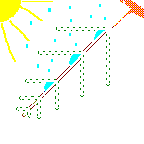 Evaporation occurs when the concrete state of water is inverse from a liquid country to a gaseous state. A considerable amount of estrus, about 600 calories of free energy for each gram of h2o, is exchanged during the change of state. Typically, solar radiation and other factors such as air temperature, vapor pressure, wind, and atmospheric pressure level bear on the amount of natural evaporation that takes place in any geographic area. Evaporation can occur on raindrops, and on gratis water surfaces such every bit seas and lakes. It tin even occur from water settled on vegetation, soil, rocks and snow. At that place is too evaporation acquired by human activities. Heated buildings experience evaporation of water settled on its surfaces. Evaporated moisture is lifted into the atmosphere from the body of water, state surfaces, and h2o bodies as h2o vapor. Some vapor always exists in the atmosphere. CONDENSATION  Condensation is the process past which h2o vapor changes it's physical country from a vapor, near commonly, to a liquid. Water vapor condenses onto modest airborne particles to form dew, fog, or clouds. The well-nigh active particles that form clouds are ocean salts, atmospheric ions caused by lightning,and combustion products containing sulfurous and nitrous acids. Condensation is brought about by cooling of the air or by increasing the amount of vapor in the air to its saturation signal. When h2o vapor condenses back into a liquid state, the same big amount of heat ( 600 calories of energy per gram) that was needed to get in a vapor is released to the environment. Atmospheric precipitation 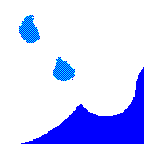 Precipitation is the process that occurs when whatever and all forms of water particles fall from the atmosphere and reach the basis. There are 2 sub-processes that cause clouds to release precipitation, the coalescence procedure and the ice-crystal process. Equally water drops achieve a critical size, the drop is exposed to gravity and frictional drag. A falling drib leaves a turbulent wake behind which allows smaller drops to fall faster and to be overtaken to bring together and combine with the lead drib. The other sub-procedure that can occur is the ice-crystal formation procedure. It occurs when water ice develops in cold clouds or in deject formations high in the atmosphere where freezing temperatures occur. When nearby h2o droplets approach the crystals some droplets evaporate and condense on the crystals. The crystals grow to a critical size and drib as snowfall or ice pellets. Sometimes, equally the pellets fall through lower elevation air, they cook and alter into raindrops. Precipitated water may fall into a waterbody or it may fall onto land. It is then dispersed several means. The water tin can adhere to objects on or well-nigh the planet surface or it tin can be carried over and through the country into stream channels, or it may penetrate into the soil, or information technology may exist intercepted past plants. When rainfall is modest and infrequent, a high percentage of atmospheric precipitation is returned to the atmosphere by evaporation. The portion of precipitation that appears in surface streams is called runoff. Runoff may consist of component contributions from such sources every bit surface runoff, subsurface runoff, or basis water runoff. Surface runoff travels over the basis surface and through surface channels to leave a catchment area called a drainage basin or watershed. The portion of the surface runoff that flows over the land surface towards the stream channels is called overland menstruum. The total runoff confined in the stream channels is called the streamflow. INTERCEPTION 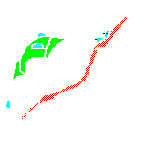 Interception is the process of interrupting the move of water in the chain of transportation events leading to streams. The interception can take place by vegetal cover or depression storage in puddles and in land formations such as rills and furrows. When rain kickoff begins, the water striking leaves and other organic materials spreads over the surfaces in a thin layer or it collects at points or edges. When the maximum surface storage capability on the surface of the material is exceeded, the cloth stores additional water in growing drops forth its edges. Somewhen the weight of the drops exceed the surface tension and water falls to the footing. Wind and the affect of rain drops tin can besides release the water from the organic textile. The water layer on organic surfaces and the drops of water forth the edges are also freely exposed to evaporation. Additionally, interception of water on the ground surface during freezing and sub-freezing conditions tin be substantial. The interception of falling snowfall and ice on vegetation also occurs. The highest level of interception occurs when it snows on conifer forests and hardwood forests that have not notwithstanding lost their leaves. INFILTRATION 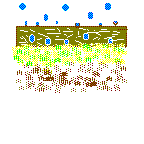 Infiltration is the physical process involving movement of h2o through the boundary area where the atmosphere interfaces with the soil. The surface phenomenon is governed by soil surface atmospheric condition. H2o transfer is related to the porosity of the soil and the permeability of the soil contour. Typically, the infiltration rate depends on the puddling of the water at the soil surface by the impact of raindrops, the texture and structure of the soil, the initial soil moisture content, the decreasing water concentration every bit the h2o moves deeper into the soil filling of the pores in the soil matrices, changes in the soil composition, and to the swelling of the wetted soils that in turn shut cracks in the soil. Water that is infiltrated and stored in the soil can too become the h2o that later is evapotranspired or becomes subsurface runoff. PERCOLATION 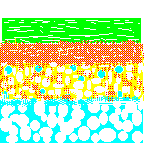 Percolation is the movement of water though the soil, and it'due south layers, by gravity and capillary forces. The prime moving strength of groundwater is gravity. H2o that is in the zone of aeration where air exists is called vadose water. Water that is in the zone of saturation is chosen groundwater. For all practical purposes, all groundwater originates equally surface water. Once underground, the h2o is moved past gravity. The boundary that separates the vadose and the saturation zones is called the water table. Ordinarily the management of water movement is changed from downwardly and a horizontal component to the motion is added that is based on the geologic boundary conditions. Geologic formations in the earth'southward crust serve as natural subterranean reservoirs for storing h2o. Others can also serve as conduits for the movement of h2o. Substantially, all groundwater is in motion. Some of information technology, however, moves extremely slowly. A geologic formation which transmits water from one location to another in sufficient quantity for economic evolution is called an aquifer. The motility of water is possible considering of the voids or pores in the geologic formations. Some formations conduct water back to the basis surface. A bound is a place where the water table reaches the ground surface. Stream channels tin can be in contact with an unconfined aquifer that approach the ground surface. Water may move from the ground into the stream, or visa versa, depending on the relative water level. Groundwater discharges into a stream forms the base period of the stream during dry periods, especially during droughts. An influent stream supplies water to an aquifer while and effluent stream receives water from the aquifer. TRANSPIRATION 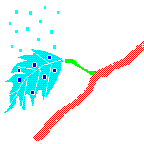 Transpiration is the biological process that occurs mostly in the day. Water inside of plants is transferred from the plant to the temper as water vapor through numerous private exit openings. Plants transpire to motion nutrients to the upper portion of the plants and to cool the leaves exposed to the sun. Leaves undergoing rapid transpiration tin exist significantly libation than the surrounding air. Transpiration is greatly affected by the species of plants that are in the soil and it is strongly affected by the amount of low-cal to which the plants are exposed. Water can exist transpired freely by plants until a h2o deficit develops in the establish and it water-releasing cells (stomata) begin to close. Transpiration then continues at a must slower rate. But a small portion of the h2o that plants absorb are retained in the plants. Vegetation generally retards evaporation from the soil. Vegetation that is shading the soil, reduces the wind velocity. As well, releasing water vapor to the atmosphere reduces the amount of direct evaporation from the soil or from snow or ice comprehend. The absorption of h2o into plant roots, along with interception that occurs on establish surfaces offsets the general effects that vegetation has in retarding evaporation from the soil. The forest vegetation tends to have more moisture than the soil beneath the trees. RUNOFF 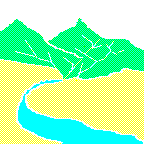 Runoff is catamenia from a drainage basin or watershed that appears in surface streams. It more often than not consists of the menstruum that is unaffected past artificial diversions, storages or other works that society might have on or in a stream aqueduct. The catamenia is made up partly of precipitation that falls direct on the stream , surface runoff that flows over the land surface and through channels, subsurface runoff that infiltrates the surface soils and moves laterally towards the stream, and groundwater runoff from deep percolation through the soil horizons. Part of the subsurface period enters the stream speedily, while the remaining portion may take a longer flow before joining the water in the stream. When each of the component flows enter the stream, they form the total runoff. The total runoff in the stream channels is called streamflow and it is more often than not regarded equally direct runoff or base flow. STORAGE 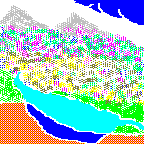 In that location are three bones locations of water storage that occur in the planetary water cycle. Water is stored in the temper; water is stored on the surface of the world, and water stored in the ground. Water stored in the atmosphere tin exist moved relatively chop-chop from one part of the planet to some other part of the planet. The type of storage that occurs on the land surface and under the basis largely depend on the geologic features related to the types of soil and the types of rocks present at the storage locations. Storage occurs as surface storage in oceans, lakes, reservoirs, and glaciers; hole-and-corner storage occurs in the soil, in aquifers, and in the crevices of rock formations. The movement of water through the viii other major concrete processes of the water cycle can be erratic. On average, water the atmosphere is renewed every xvi days. Soil wet is replaced most every twelvemonth. Globally, waters in wetlands are replaced virtually every 5 years while the residence time of lake water is about 17 years. In areas of depression evolution by society, groundwater renewal can exceed 1,400 years. The uneven distribution and movement of water over fourth dimension, and the spatial distribution of water in both geographic and geologic areas, can crusade farthermost phenomena such every bit floods and droughts to occur.
ESTIMATED
GLOBAL WATER CYCLE TYPE OF LOCATION VOLUME Pct OF TOTAL Water millions of millions of VOLUME cu. miles cu kilometer Salt Water 97.00 oceans 314.ii 1308.0 (96.4%) saline bodies 2.one 8.vii (0.6%) FRESH H2o 2.ninety water ice & snow half-dozen.ix 28.vii (2.1%) lakes 0.v ii.1 (0.15%) rivers 0.01 0.04 (0.003%) attainable groundwater 1.0 4.ii (0.31%) ATMOSPHERIC 0.10 sea evaporation 0.1 0.42 (0.03%) country evaporation 0.05 0.21 (0.015%) precipitation over sea 0.09 0.37 (0.03%) precipitation over land 0.03 0.12 (0.01%) h2o vapor 0.005 0.02 (0.002%) ROUNDED TOTAL 326.00 1357.00 100.0
If a 50-v gallon drum of water represented the total supply of water on the planet and so: a) the oceans would be represented by 53 gallons, 1 quart, 1 pint and 12 ounces;
b) the icecaps and glaciers would represent one gallon, and 12 ounces;
c) the atmosphere would contribute 1 pint and 4.5 ounces;
d) groundwater would add up to 1 quart, and 11.4 ounces;
e) freshwater lakes would represent i one-half ounce;
f) inland seas and saline lakes would add together up to over 1 tertiary of an ounce;
g) soil moisture and valdose water would total to nearly one fourth of an ounce;
h) the rivers of the world would only add up to i-hundredth of an ounce (less than ane one-millionth of the water on the planet).
H2o Budget IN THE The states The atmosphere above the 48 coterminous The states of America stores about 36.5 cubic miles per day of atmospheric water. A little over x percent or 3.9 cubic miles of information technology falls as precipitation each day. About 1,430 cubic miles of precipitation fall over the 48 states annually. This volume would be plenty each year to comprehend u.s. with about 30 inches of water. The greatest boilerplate yearly precipitation in the world of 460 inches (1,168 cm) occurs at Mt. Waialeale, Hawaii. The everyman average almanac precipitation of 1.63 inches ( iv.i cm) in the United States occurred over a 42-yr period in Expiry Valley, California. The longest dry out period with no precipitation in the Usa occurred during a 767 day catamenia from October 3, 1912 to November 8, 1914 at Bagdad, California. An boilerplate of 70 percent of the almanac atmospheric precipitation to the coterminous U.S. ( 1,001 cubic miles) evaporates back into the atmosphere from land and water surfaces and by transpiration from vegetation. The remaining thirty per centum of the annual precipitation ( 429 cubic miles) is transported through the other surface and subterranean processes of the water cycle to a stream, lake, or ocean. Groundwater storage in the coterminous United States has been estimated to exist nearly xv,100 cubic miles both in the shallow groundwater (less than 2,600 feet deep) and an equal amount in the groundwater deeper than two,600 feet. Soil moisture in the top 3 feet of soil is estimated to be equivalent to about 150 cubic miles of water. The United States has approximately 4,560 cubic miles of h2o stored in freshwater lakes. Although in that location are about five,540 cubic miles of water are stored in the Bang-up Lakes alone, over fifty percent of the volume is considered to exist in the United States. Also, about fourteen cubic miles are stored in salt lakes of the nation. In addition, there is approximately 12 cubic miles of surface waters stored in stream channels in road to the oceans. Other sources of surface storage in the coterminous states include 16 cubic miles of frozen h2o in glaciers. The stream menses volume that reach the oceans of the nation is about one.12 cubic miles per mean solar day ( 409 cubic miles per year). The total combined surface and groundwater flow to the nation's oceans is 1.18 cubic miles per 24-hour interval. The Mississippi River alone contributes 0.34 cubic miles per mean solar day (annual natural runoff of 593,000 cubic feet per second). There are approximately 2700 reservoirs and controlled natural lakes of more than than 5,000 acre-feet in storage in the United states of america. The reservoirs provide 142 cubic miles of storage, most 90% of which occurs in 600 of the largest reservoirs. Also, there are approximately 50,000 reservoirs ranging from 50 to five,000 acre-feet in storage. It is as well estimated that there are about 2 meg subcontract ponds in the United states of america. Most of the major reservoirs in the nation are endemic by the public. The Bureau of State Management is the manager of the near federal dams (over 750), just most are small-scale dams. The larger reservoirs are managed by the U.S. Army Corps of Engineers, the Agency of Reclamation, and the Tennessee Valley Authority. The Corps has built and operates almost 600 dams and reservoirs ,the Agency of Reclamation operates nearly 300 dams and reservoirs, and the TVA has over l dams and reservoirs. Other federal agencies that manage small dams include the US Forest Service with virtually 400, the Bureau of Indian Affairs with over 300, the National Park Service with over 260, the US Fish and Wildlife Service with over 175, and the Section of Free energy with near 30 dams. H2o IN THE Land OF OREGON Oregon is divided into two distinct rainfall zones by the Cascade Range. The annual precipitation due west of the Cascade Mountains ranges from xl to 140 inches. Due east of the Cascades, precipitation ranges from 10 to 20 inches per year. The average annual precipitation for the unabridged state is 28 inches. The boilerplate annual runoff is about 20 inches. The state has a network of 112,000 miles of rivers and streams to accommodated the annual runoff. There are over 365 waterfalls mapped in Oregon that are in the cascade and the cataract categories of waterfalls. Cascade waterfalls have pocket-sized volumes of water with perpendicular movement of the flowing water often associated in a succession of stages. Cataract category waterfalls take large volumes of water that motility perpendicularly. Over 120 geothermal hot springs in the country have been identified with h2o temperatures that are 15 degrees F above the mean almanac air temperature. The total groundwater supply in Oregon has not been quantified. Oregon has an estimated available, annual surface h2o supply of over 66 million acre-feet (19.5 cubic miles). Differences in the seasonal and geographic distribution of water resources throughout the state results in annual water shortages in many areas of the state, particularly in eastern Oregon. Utilize of natural menstruum of surface waters, surface storage in reservoirs, and ground water supplies from aquifers are used to meet the yr effectually demands. The major river affecting Oregon is the one,243 mile long Columbia River. It forms much of Oregon's northern border with the country of Washington. I of the Columbia's major tributaries, the Snake River forms a major portion of the eastern border of Oregon with Idaho and is the location of the 7,900 feet deep Hell'due south Canyon. The Columbia River originates in adjacent states of Washington, Idaho, and Montana and in Canada. The average annual flow is 265,000 cubic feet per second. This volume represents 0.15 cubic miles per day. Other major watersheds in Oregon can be divided into twenty additional basins. They include: Northward Declension Drainages Malheur Willamette Owyhee Sandy Malheur Lake* Deschutes Klamath John 24-hour interval Chetco Umatilla Rogue Grande Ronde South Coast Drainages Pulverisation Umpqua Serpent Mid-Declension Drainages There are 7 watersheds that empty into the Pacific Ocean. Two of the basins (*) are airtight basin and do not discharge water to the ocean or to receiving streams. Eleven are interior basins that empty into receiving streams. Oregon abounds with over six,000 natural lakes, ponds, marshes, sloughs and reservoirs. Over 1,400 of them are named lakes. They have a combined surface surface area of 500,000 acres (781 foursquare miles). Hundreds of the lakes are unnamed. There are 13 Lost Lakes, xi Blue Lakes, 10 Clear Lakes and 10 Fish Lakes. They range in surface area size from a maximum of 90,000 acres (141 square miles) at Upper Klamath Lake to cattle pond, farm ponds, and manufactory ponds of less than one acre. Crater Lake is the deepest lake in the U.s.a.. It is 1,932 feet deep, with a chapters of 14 million acre-feet (iv.xiv cubic miles) and a surface area of 13,139 acres (20.five square miles). Following heavy rainfall and runoff during in 1984, Malheur and Harney lakes in southeastern Oregon were joined together for several years. Malheur Lake and Harney Lake are again separate lakes, but continued as part of a closed bowl wetland system, with Malheur Lake being about 90,000 acres. The Malheur Lake complex is still considered the largest natural body of h2o in Oregon. The 180,000 acres (281 square miles) of the lake/wetland complex located in the airtight basin forms the largest freshwater marsh in the western contiguous U.s.a.. Other large lakes in Oregon include Waldo, Odell, and Wallowa lakes. More than half of the lakes in the country are volcanic or glacial depressions located on the loftier pinnacle areas between the summits of the Cascade Range. Nearly 100 of the natural lakes are clustered in the Wallowa Mountains of northeastern Oregon. Many other lakes are located between sand dunes near the Oregon shore. Many of the natural lakes throughout the state have had water command structures congenital at their outlets to enhance storage in the lakes and to control the release of stored water for downstream irrigation. Oregon has more 60 reservoirs with capacities of over 5,000 acre-feet each. The largest reservoir in the country is the Bureau of Reclamation's Owyhee Lake in southeastern Oregon with over 1 meg acre-feet ( 0.iii cubic miles) of storage. Virtually of the reservoirs in Oregon were built, at least partially, to shop irrigation h2o. There are hundreds of pocket-size unmarried purpose reservoirs built by local irrigation companies. Rarer types of unmarried purpose reservoirs include recreation reservoirs, fish and wild fauna reservoirs, and water quality enhancement reservoirs. Reservoirs are more often than not characterized by their project purposes. H2o supply reservoirs are distinguished by large storage volumes that are capable of providing an expected annual supply of water and capable of outlasting most droughts. Irrigation reservoirs have large conservation pools with maximum conservation pools at the showtime of the growing season and a minimum pool during the nongrowing season. Flood command reservoirs accept a minor permanent pools with a large storage capacities to reduce downstream water levels primal locations on rivers. Another characteristic of inundation command reservoirs is that they are generally drawndown as rapidly every bit possible following a loftier runoff effect to reestablish their storage capabilities. A hydroelectric reservoir is characterized by storage and release properties that meet regional energy demands, especially during the winter or the summer. Re-regulation reservoirs are congenital below hydroelectric dams to stabilize h2o flow in rivers to reduce catamenia fluctuations betwixt daily power generation periods. Headwater storage reservoirs for navigation purposes have large storage pools at the get-go of the dry season and they release plenty water to support seasonal navigation traffic. Lock and dam reservoirs, withal, back up waterborne navigation by creating slightly vary pools that extends upstream a considerable distance from the run-of-river projects. Usa Army Corps of Engineers reservoirs are multiple purpose impoundments meeting several types of water resources needs such as flood control, hydroelectric power generation, navigation, irrigation, municipal and industrial water supply, water quality, fisheries, and recreation. The Portland District, Corps of Engineers built and operates three run-of-river reservoirs on the main stalk of the lower Columbia River, Bonneville, The Dalles, and John Day dams, that meet navigation, hydroelectric power, irrigation, fisheries, water quality and recreation needs. The Portland District also has built and operates 13 multiple purpose storage projects with a total capacity of 2,308,020 acre-feet of h2o at maximum conservation puddle ( 0.68 cubic mile) in the Willamette River Basin. The district also stores 547,191 acre-feet of water (0.16 cubic mile) at the maximum pools of the two Rogue River Basin projects. Additionally, John 24-hour interval Dam, on the Columbia River, has 534,000 acre-anxiety (0.xvi cubic miles) of usable storage. Portland District's Willow Creek Dam, on the north primal Oregon tributary to the Columbia River, stores 6,249 acre-feet (0.002 cubic miles) at it's normal summer conservation pool level. Therefore, the total volume of water stored in Portland Commune reservoirs is equivalent to over 75 percent of the single daily flow of water from U.S. rivers into the oceans. The scheduling of water storage and release from dams is function of a water resource engineering science function called reservoir regulation. Provided past Corps of Engineers - Portland Commune |









